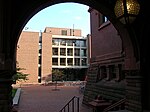Sansom Row
Historic districts in PhiladelphiaHistoric districts on the National Register of Historic Places in PennsylvaniaHouses completed in 1871Houses in PhiladelphiaHouses on the National Register of Historic Places in Pennsylvania ... and 6 more
NRHP infobox with nocatNational Register of Historic Places in PhiladelphiaNeighborhoods in PhiladelphiaPhiladelphia County, Pennsylvania Registered Historic Place stubsSecond Empire architecture in PennsylvaniaUniversity City, Philadelphia

Sansom Row is a row of historic houses at 3402 to 3436 Sansom Street in the University City neighborhood of Philadelphia, Pennsylvania. Built in 1869 to 1871, the rowhouses are constructed in matching three-story pairs, with brownstone facades and slate mansard roofs. They are significant as a surviving example of post-Civil War architecture in the area. Madame Blavatsky, a founder of Theosophy and the Theosophical Society, lived here at 3420 Sansom Street for a time.The houses were built as residences but most have been converted to other, mainly commercial uses.
Excerpt from the Wikipedia article Sansom Row (License: CC BY-SA 3.0, Authors, Images).Sansom Row
Grays Ferry Bridge Path, Philadelphia South Philadelphia
Geographical coordinates (GPS) Address Nearby Places Show on map
Geographical coordinates (GPS)
| Latitude | Longitude |
|---|---|
| N 39.953333333333 ° | E -75.193055555556 ° |
Address
University of Pennsylvania
Grays Ferry Bridge Path
19104 Philadelphia, South Philadelphia
Pennsylvania, United States
Open on Google Maps







